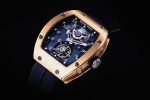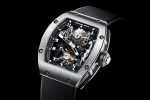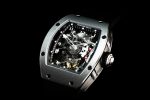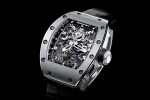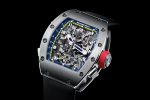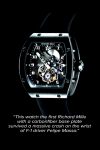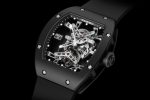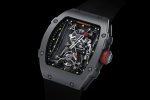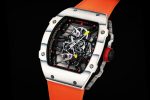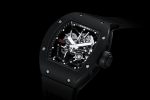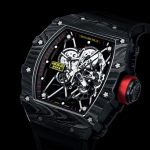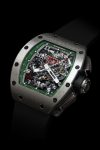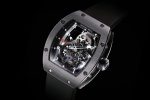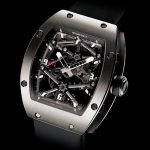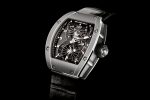Reviews
THE GAME CHANGER
Who else would create the world’s first wristwatch with a carbon-fiber baseplate for an F1 driver to wear on the racetrack, and joke that despite a horrendous crash, the watch continued to work perfectly? Who else would introduce materials previously associated only with aerospace into the watch, and bring unparalleled shock resistance, lightness and rigidity to every component of the watch, at the same time introducing architectural geometry and forms derived from F1 cars?
A full decade and a half into his brand’s existence, Richard Mille represents the most significant influence on contemporary horology in the last half-century.
This is the story of how he totally and irrevocably changed the game.
“Bonjour, Richard Mille,” he says, his distinct baritone like a cosmic cannon shot. It’s a sonic boom over the desert sky. It bounces and careens off the walls, encapsulating the man, the myth, the legend with the same fierce, compact economy and force of will as René Descartes’s cogito ergo sum.
But who is Richard Mille? What’s the man behind the machine all about? He’s a gentleman of exquisite refinement and a man of enormous presence. So as he crosses any threshold and makes that incredible pronouncement of self, “Bonjour, Richard Mille,” the room literally resonates with his energy. Funnily, the only time he was reticent about wielding his mighty name was when we were stopped at the gates of Le Mans by an overeager security guard. Behind, an enormous ‘Richard Mille’ banner soared overhead. The guard politely asked, “Sir, may I ask your name and the nature of your business at Le Mans?” Mille smiled and intoned, “My name is Richard and I am in the business of passion, my friend — always passion!”
What was coalescing in Mille’s mind was not a watch, but a prevailing philosophy. Mille explains, “The Mille watch is the result of an entirely new global belief system. Every aspect of the watch — from the way it was conceptualized, to the way it was built, to the materials it used, to its resulting aesthetic — was the result of this global system focused on three things: ultimate shock resistance, ultimate lightness and ultimate ergonomics. I wanted to make watches in the way F1 cars were created, as high-performance dream machines without a single iota of compromise.” This ethos of ‘no compromise’ would become an evangelical tenet for Mille and the fundamental precept of the Mille religion.
On 7 June 2010, a revitalized and transformed Rafael Nadal came back from what had previously been one of his worst seasons to become the most dominant force in professional tennis. On this day, he was unstoppable, playing his unique blend of tennis, best described as sheer entropy, non-stop kinetic magic as he blitzed past Robin Söderling in straight sets to win his fifth French Open, his seventh Grand Slam and be reinstated as the highest-ranked player in the world. As he raised his trophy above a jubilant crowd, on his right wrist was a marvel of engineering: a carbon-fiber-cased, aluminum-lithium tourbillon watch that had been his companion through every single stroke of every set throughout the tournament: the RM 027. This 20g masterwork of technological innovation was made by Richard Mille and is proof positive that his watches can be worn in even the most brutal and punishing conditions. But for Mille, without this extreme test and vindication, the exercise of making the world’s lightest mechanical watch would have been meaningless.
Mille is quick to point out that each of his forays into extreme lightness has always been accompanied by a real performance objective linked to an elite athlete. His 48g RM 006 and his 28g RM 009 were both created to be worn by F1 driver Felipe Massa during races.
What Mille achieved by equipping Nadal with a tourbillon wristwatch that he wore to victory in every single match of the French Open, Wimbledon and the US Open, was totally unprecedented. While multitudes of watch brands sponsor athletes across an array of sports, not one of them has ever worn a mechanical watch, much less a tourbillon, while in competition. That Nadal did and that the watch obviously had zero negative influence on his game, is proof positive of Mille’s assertion that his timepieces are ultimate performance instruments.
He explains, “I consider Rafael Nadal and Felipe Massa to be partners. And the critical difference is that I am not interested in having them wear my watches in ads or off-court, or away from the racetrack. I want them to test my watches in competition; I want them to use the watches to the very limits of pressure and even to abuse the watches to demonstrate their value as high-performance technical instruments.”
Winning Nadal over to the idea of wearing a watch during competition, says Mille, was no easy task. “I knew he would be really hard to convince. He is a total maniac when it comes to preparation and details. When he comes onto court, he has to arrange his drinks in a certain way; he has a certain routine and he cannot deviate from this in any way.” When he first broached the subject with Nadal, Mille recalls, “He immediately said, ‘No way. It is impossible. I cannot wear a watch when I play. It would destroy my balance; it would make me lose focus. It would be a disaster.’” Not one to shrink from a challenge, however, Mille says, “It became something of a mission for me to convince him to wear the watch when he was playing. This dictated four objectives for the watch I would create. The first was lightness, the second was shock resistance, the third was comfort, and the fourth was no compromise mechanically, which meant, for me, to create a tourbillon for this watch.” An encounter between Nadal and the King of Spain, who rhapsodized over the comfort and lightness of his RM 009 tourbillon, prompted the tennis champion to reconsider the idea — at least, in principle. “Finally,” says Mille, “he agreed to try it out, with no promises that he would wear it during competition.” Thus began development of the RM 027.
To isolate the tourbillon device from shocks — in particular those during Nadal’s ferocious backhand — the movement rides on shock absorbers, or silentblocs (rubber elastomers). Says Mille, “I wanted a case where the maximum of things were integrated so that fewer things could flex.”
To make a super-light case, Mille utilized a material that he introduced to the watch industry with his watch, the RM 006. He explains, “When I began, I wanted to use carbon fiber on the most critical part of the timepiece, the baseplate, which is the skeleton of the watch. The watch we made, the RM 006, was actually on the wrist of Felipe Massa when he suffered a horrible crash of over 30Gs, and it survived with not even a need for the slightest adjustment. Now, I decided to use carbon nanofiber for the case of Nadal’s watch. The objective was to have the case as light as possible but rigid enough, because the force is so violent, it could twist the case. So instead of a normal three-piece case, I made it monobloc.” To shave off the final few grams, Mille decided not to use a sapphire crystal, but a type of high-end Plexiglas you find in racecars instead. He says, “What we did was adapt an extreme machine for a very extreme purpose.”
During the US commentary for the French Open, the irascible former player and now commentator, John McEnroe, went on something of a prolonged rant proclaiming that he couldn’t believe Nadal was wearing a “half-million-dollar watch” that smacked not too vaguely of jealousy, but to focus on the price of the RM 027 is to miss its point entirely. Says Mille, “Nadal is an incredibly humble guy and he doesn’t know how to reply to a commentator like John McEnroe when he asks something like how a watch can cost USD500,000. So he replies that this watch is a technical exercise, and I think this is good because I don’t want him to oversell the watch. The fact that he wore it while playing was the best testament he could make.”
Mille believes that in order to understand the appeal of the ultra-light performance timepiece, you need to first overcome the brainwashing about social status related to traditional luxury materials like gold and platinum. Mille explains, “The ultra-light watch is for you when you don’t need to prove anything to anybody, when you are ready to go for the extreme in comfort, the extreme in ergonomics, the extreme in performance, then you have arrived at a stage of maturity where you are ready for the extreme in lightness.”
Says Mille, “This is the fundamental message of Richard Mille. It is the brand for when you have gone past the preconceptions about traditional luxury. For me, it is not the first watch a collector will buy, but it is the last one he will buy once he has transcended beyond everything else and buys this watch only to please himself.”
Mille’s focus on ultra-light ‘racing machines for the wrist’ has resulted in a radical evolution in thinking for high-end-watch collectors. Says Mille, “Before me, gold was a symbol of wealth; it was a sign of importance, it expressed luxury. It was funny because I wanted to convince people to wear much lighter watches, but it was not easy. I was the first to put a tourbillon inside a titanium case, but some people felt that it was almost a waste of money. It’s funny, now we sell many more watches in titanium and in carbon fiber than in platinum.”
When asked where he draws the line in terms of materials innovation, Mille is quick to reply, “I want to ensure that 50 years from now, the integrity of the case and of the baseplate is still there. There are materials that I refuse to use because of this. As a collector of vintage racecars, it is important to me that beautiful things continue to exist and are easy to be maintained. There are many people who introduce materials to watchmaking just to be sexy, but this is very superficial. And in a few years’ time, when these watches are very difficult to repair, it is the consumer who suffers.”
Look at any Richard Mille watch and you’ll be drawn inside its hypermodern mechanical universe, almost like descending into a futuristic cityscape. Says Mille, “It made sense to have my watches be transparent, for several reasons. The first is, if I were going to have an enormous amount of hand-finishing, then it made sense to show it off. The second thing was, many brands would want to create something modern-looking on the outside, but on the inside, they use exactly the same movement as everyone else. I want to demonstrate the extremes I had gone to make the movement of the watch the most innovative part of it.”
Put a Richard Mille watch on, and despite its substantial size, you’ll find yourself forgetting it’s there. This is thanks to the extraordinary ergonomics engineered into Mille’s timepieces.
Says Mille, “In the watch business, we work with antagonistic shapes. The movement that is central to the watch’s architecture must be flat, yet at the same time, we are striving to make the case curved and ergonomic. In order to reconcile these two elements, you have to bring in a lot of technical elements, even to the point of reconfiguring the gear train, so that the case can become as comfortable as possible. For brands that use ubiquitous movements and then try to adapt a case, this is very difficult, but because I always work from scratch, ergonomics is of primary importance even at the stage of movement development. This is similar to F1 — for example, the body of the car is always moving toward further aerodynamics, but the shape of the engine, which is a constant, must always be integrated. In addition, in F1, you must avoid overheating and balance issues, and so the engineering teams for the body and the engine must work together. I feel this is exactly the way you must work with watches, taking the human body as the constant, because they are meant to be worn.”
In many ways, Richard Mille represents the final evolutionary step in any watch collector’s progression. Says Mille, “My watches are for when we escape from the superficial to the real thing. It is an evolution not just of the watch, but of the collector. It is the door to the future. One subject that is most often discussed with regard to Mille’s overt modernity is the question: how will Richard Mille be perceived in the future? My belief is, though his watches were revolutionary when they first emerged, I think they will become future classics. When the Barcelona chair or the Ferrari 250 GTO were first created, they were groundbreaking. Today, they are classics and as relevant as they were when they were first created, by virtue of their originality. Similarly, we can see Richard Mille’s already-15-year-old RM 001 and six-year-old RM 027 are just as electrifyingly relevant as the day they were created. They are horological milestones recognized for their aesthetics as well as the lofty performance parameters which they established.
Opening photograph by Thomas Lavelle for Revolution.






